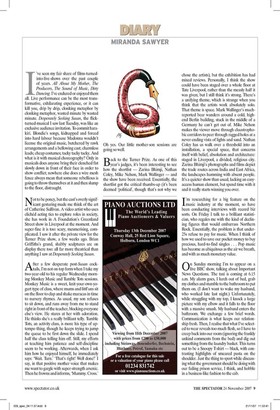Diary
MIRANDA SAWYER 1 've seen my fair share of films-turnedinto-live-shows over the past couple of years. All About My Mother, The Producers, The Sound of Music, Dirty Dancing: I've endured or enjoyed them all. Live performance can be the most transformative, exhilarating experience, or it can kill you, drip by drip, clonking metaphor by clonking metaphor, wasted minute by wasted minute. Desperately Seeking Susan, the flickturned-musical I saw last Tuesday, was like an exclusive audience invitation. To commit harakiri. Blondie's songs, kidnapped and forced into hard labour because Madonna wouldn't license the original music, butchered by rawk arrangements and a bellowing cast; charmless leads; cheap costumes; tacky tacky tacky. And what is it with musical choreography? Only in musicals does anyone bring their clenched fist slowly down in front of their face in order to show conflict; nowhere else does a wire mesh fence always mean that someone rebellious is going to throw themselves at it and then slump to the floor, distraught.
Not to be poncy, but the cast's overly significant gesturing made me think of the art of Catherine Sullivan. A video artist who uses cliched acting tics to explore roles in society, she has work in A Foundation's Greenland Street show in Liverpool at the moment. And super-fine it is too: scary, mesmerising, complicated. I saw it after the private view for the Turner Prize show, a few weeks ago. Brian Griffiths's grand, shabby sculptures are on display there too: all far more theatrical than anything I saw at Desperately Seeking Susan.
After a few desperate post-Susan cocktails, I'm not on top form when I take my two-year-old to his regular Wednesday morning Monkey Music and Tumble Tots sessions. Monkey Music is a sweet, knit-your-own-yogurt type of class, where mums and littl'uns sit on the floor to clap and shake maracas in time to nursery rhymes. As usual, my son refuses to sit down, and runs away from me to stand right in front of the teacher, blocking everyone else's view. He stares at her with adoration. He thinks she's a really brilliant telly. Tumble Tots, an activity class, is more his type of uptempo thing, though he keeps trying to jump the queue to be first down the slide. I spend half the class telling him off. Still, my efforts at teaching him patience and self-discipline seem to be working. Afterwards, when I ask him how he enjoyed himself he immediately says: 'Wait. Turn.' That's right! Well done!' I say, in that positive mother voice that makes me want to gargle with super-strength arsenic. Then he frowns and informs, 'Mummy. Cross.'
Oh yes. Our little mother-son sessions are going so well.
Back to the Turner Prize. As one of this _L./year's judges, it's been interesting to see how the shortlist — Zarina Bhimji, Nathan Coley, Mike Nelson, Mark Wallinger — and the show have been received. Essentially, the shortlist got the critical thumbs-up (it's been deemed 'political', though that's not why we chose the artists), but the exhibition has had mixed reviews. Personally, I think the show could have been staged over a whole floor at Tate Liverpool, rather than the measly half it was given; but I still think it's strong. There's a unifying theme, which is strange when you think that the artists work absolutely solo. That theme is space. Mark Wallinger's muchreported bear wanders around a cold, highend Berlin building, stuck in the middle of a Germany he can't get out of. Mike Nelson makes the viewer move through claustrophobic corridors to peer through ragged holes at a never-ending vista of lights and sand. Nathan Coley has us walk over a threshold into an installation, a special space, that concerns itself with belief absolution and architecture: staged in Liverpool, a divided, religious city. Zarina Bhimji's photographs and films depict the trade routes across India and East Africa, the landscapes humming with absent people. It's a quieter show than usual, lacking an easyaccess human element, but spend time with it and it really starts winning you over.
T 'm researching for a big feature on the music industry at the moment, so have been conducting interviews with record biz sorts. On Friday I talk to a brilliant statistician, who regales me with the kind of declining figures that would embarrass Northern Rock. Essentially, the problem is that under25s refuse to pay for music. When I think of how we used to save our pocket money to buy precious, hard-to-find singles . . . Pop music has become as ubiquitous as the air we breath, and with as much monetary value.
n Sunday morning I'm to appear on a live BBC show, talking about Important News Questions. The taxi is coming at 6.15 a.m. My alarm goes, I lurch out of bed, grab my clothes and stumble to the bathroom to put them on. (I don't want to wake my husband, who worked late last night.) Unfortunately, while struggling with my top, I knock a large picture with my elbow and it falls to the floor with a massive smash. My husband enters the bathroom. We exchange a few brief words. Communication is what keeps our relationship fresh. Then, I realise that what I've selected to wear reveals too much flesh, so I have to creep back into our room (ignoring the frankly unkind comments from the bed) and dig out something from the laundry basket. This turns out to be a Snoopy T-shirt — black, with contrasting highlights of smeared pasta on the shoulder. Just the thing to sport while discussing what the government should be doing with our failing prison service, I think, and hobble in a business-like fashion to the cab.






































































 Previous page
Previous page